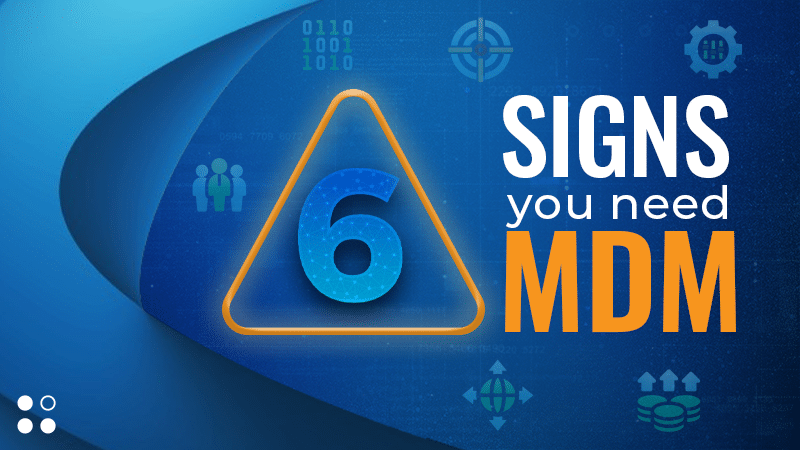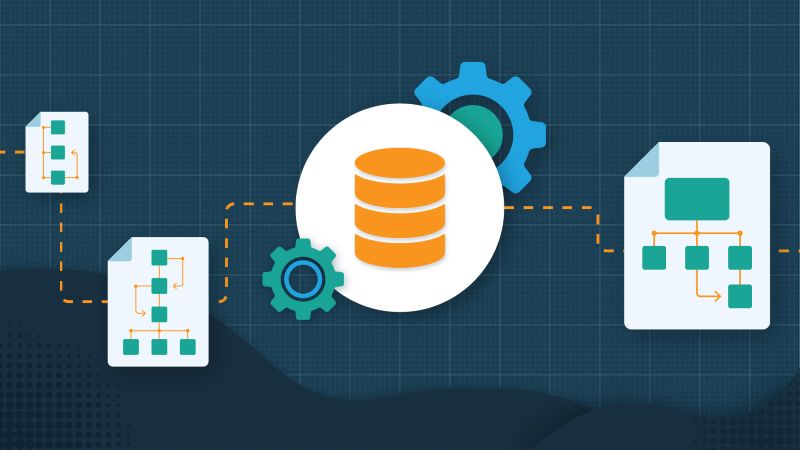Master data management (MDM) is critical to digital transformation. To understand why, you first need to understand what it is. MDM is a process of consolidating, enriching and managing all the important data that is shared widely within an organization so that it can be accessed and used consistently across the enterprise.
MDM is especially critical in today’s digital age when data is scattered throughout the organization in multiple formats, locations, and quality standards. By consolidating and managing this data, MDM enables organizations to effectively and efficiently leverage their enterprise data as a strategic asset.
There are six signs that an organization should consider implementing an MDM platform:
- A lack of AI readiness
- Questionable reports and analytics
- Overly complex data integrations and pipelines
- Inefficient mergers and acquisitions
- Audit and compliance risk
- Rampant data hoarding and duplication
Let’s take a closer look at each of these six signs.
1. A Lack of AI Readiness
The top sign that your business may need MDM is that your leadership has concluded the state of your internal data is precluding you from being ready for the deployment of AI-based solutions within your company. Concerns about low quality, duplicated or inconsistent data across business functions is making leadership teams concerned that using this data as inputs for LLMs or other generative AI (GenAI) solutions will create potentially disastrous business outcomes, like those experienced recently by Air Canada.
The Master Data Management Solution: Consumable Master Data Products
Master data management enables the creation of highly governed datasets which are trusted, accurate and consistent over time — which is exactly what the organization needs to minimize situations where LLMs hallucinate or provide completely erroneous insights. These consumable master data products can then be widely distributed across the organization for consumption by any downstream system or process, including AI systems, to ensure the performance of those systems is fully optimized.
2. Questionable Reports and Analytics
Organizational disarray is when no one can agree on the right response to data-intensive and business-critical questions, like “How many customers do we have?” When it’s impossible to provide a quick and consistent answer to some of the most important questions your business needs to answer, a lack of master data management is the most likely culprit.
In the age of digital transformation, you need quick answers when your CEO wants a 360-degree view of its customers or when your VP of procurement needs a quick insight on the total spend with a given supplier. However, when a company lacks MDM, the data needed to provide those insights is trapped in silos across the organization in different formats, with different quality standards and different definitions.
When this disparate, fragmented data works its way into analytics, it creates chaos by prohibiting the consumers of the data from being able to trust it or make confident decisions based on it.
The Master Data Management Solution: Data Consolidation
An MDM platform can help to resolve this issue by consolidating all the important data into a single, centralized location. It allows for a common set of governance and quality standards to be applied to the data so that downstream analytical systems can provide accurate, trustworthy and consistent insights to business consumers. This makes the data easier to access and use and eliminates the inconsistencies that can occur when different departments are using different data sets.
3. Overly Complex Data Integrations and Pipelines
Over time, as an organization grows and more and more data silos emerge, many data management organizations turn to their extract, transform and load (ETL) and data pipeline processes to help resolve differences that naturally form over time across source data sets.
The more silos and “data drift” that happens, the more complex and brittle the ETL processes needed to resolve data become. These process often include logic to resolve differences in data quality or data definitions as well.
Data pipelines start to break down, and when the person who created the original ETL processes leaves the business, it can be time consuming and costly to try to reverse engineer those processes to bring them back online should they fail. These complex processes are a tell-tale sign the organization needs MDM.
The Master Data Management Solution: A Single Data Integration and Quality Hub
Master data management provides for the implementation of a single hub to apply complex data quality rules across multiple sources, and consumers, of data. It allows for rules to be configured — not coded — and it provides full visibility and auditability of any of the transformations being applied to source data prior to that data being consumed in downstream analytical and operational systems.
DATA INSIGHTS,
DIRECT TO YOUR INBOX
4. Inefficient Mergers and Acquisitions
Consider that your enterprise has just acquired another company whose products are complementary to your services. Everyone sees this as a big win since it’s expected to drive significant economies of scale through the combination of the two entities.
Added value through increased cross-selling opportunities, reduced supplier spends or more efficient management of inventories are just some of the many expected outcomes. But instead of the merger becoming a massive efficiency boon for the company, it creates an operational headache caused by drastic differences in how each of the companies manages and governs their core data assets.
Aggregated reports are completely inaccurate, and the length of time needed to combine the two businesses significantly exceeds all original expectations.
The Master Data Management Solution: Fast and Accurate Mergers and Acquisitions
An MDM platform can speed up the data integration process required during a major merger activity, enabling your organization to integrate data quickly and accurately from the two companies. This will allow you to take full advantage of all possible operating efficiencies and capitalize on the synergies between the two organizations.
5. Audit and Compliance Risk
If your auditors or your CFO have recently expressed significant concerns about a lack of knowledge about where data resides, who has access to it or the controls used to govern and manage it in a way that complies with regulatory guidelines, this may be a sign that you need better MDM.
Organizations who do not implement data governance supported by a robust MDM program lack the critical understanding about what personal data their business has on individuals and where it is stored across the organization.
In this scenario, the requirement of the business to reduce risk by maintaining regulatory compliance may be in jeopardy. The General Data Protection Regulation (GDPR), for example, mandates that a company must enable customers to access their personal data, to be forgotten if they choose and to have their data ported to third parties, as well as to be notified promptly of data breaches.
Fail at this, and your company can face fines of up to €10 million ($11.4 million USD) or 2% of the firm’s worldwide annual revenue from the preceding financial year — whichever amount is higher.
The Master Data Management Solution: Trusted Enterprise-Wide Data Governance
An MDM platform can help to address the issue of lack of data governance on sensitive data by providing an enterprise-wide framework and supporting technology for governing it. This framework will help to ensure that the data is accurately captured and tracked and that it meets the organization’s specific governance needs and requirements.
6. Rampant Data Hoarding and ESG Concerns
Unchecked data hoarding and duplication is an outcome of a lack of a consistent and logical approach for promoting data consistency and widespread sharing within an enterprise.
This is why up to 73% of company data goes unused for analytics and why most data sitting in data centers is considered “dark.” This represents both a significant cost burden, and a growing burden on our environment, given the amount of energy required to house it.
MDM is both a technology and a discipline. The lack of a structured discipline for managing data that is shared widely across the organization will promote the creation of silos, which results in significant duplication of data.
The Master Data Management Solution: Data Sharing
By creating consistent, accurate, and trustworthy data about the most important assets in your business, MDM promotes and enables widespread data sharing. The more data can be shared and re-used, the less likely it is to be unnecessarily duplicated within individual business functions or domains. MDM also provides accurate insights and visibility across complex business processes (such as supply chains), which will be increasingly critical for organizations to comply with as ESG regulations — such as the Product Passport initiative in the EU — evolve.
Interested in learning more? Download a copy of the Complete Guide to Master Data Management below.

Malcolm Hawker
Malcolm Hawker is a former Gartner analyst and the Chief Data Officer at Profisee. Follow him on LinkedIn.















